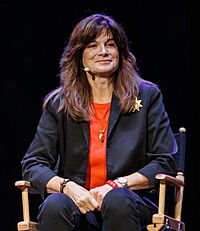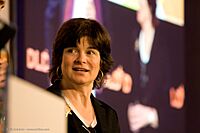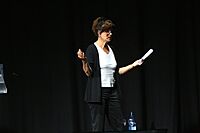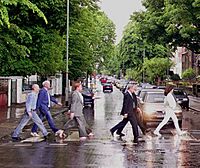Carolyn Porco facts for kids
Quick facts for kids
Carolyn Porco
|
|
|---|---|
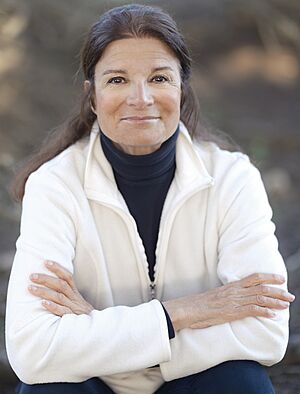
Porco in 2021
|
|
| Born | March 6, 1953 Bronx, New York, U.S.
|
| Alma mater | California Institute of Technology Stony Brook University |
| Known for | Leader of Cassini Imaging Team; Discoveries about Saturn system; Member of Voyager Imaging Team; Expert in Planetary rings and Enceladus; The Day the Earth Smiled; Science communicator & public speaker; Film consultant. |
| Awards | Porco asteroid; Lennart Nilsson Award (2009); AAS Carl Sagan Medal (2010); Caltech Distinguished Alumni Award (2011); Time 25 Most Influential People in Space (2012) |
| Scientific career | |
| Fields | Planetary science Imaging science |
| Institutions | Cassini Imaging Central Laboratory for Operations, University of Colorado at Boulder |
| Doctoral advisor | Peter Goldreich |
Carolyn C. Porco (born March 6, 1953) is an American planetary scientist. She studies the outer parts of our Solar System. Her work began in the 1980s with the Voyager missions. These missions explored Jupiter, Saturn, Uranus, and Neptune.
Later, she led the team that took pictures for the Cassini mission. This spacecraft orbited Saturn. Carolyn Porco is an expert on planetary rings and Saturn's moon, Enceladus.
She has written over 110 science papers. These papers cover many topics, like how light interacts with Uranus and Neptune. She also studied how planetary rings reflect light and how moons affect rings. Her work includes computer models of rings and heat flow inside Jupiter. She also shared many discoveries about Saturn's atmosphere, moons, and rings from the Cassini mission. In 2013, Cassini data proved a prediction she made in 1993. She and Mark Marley predicted that sounds inside Saturn create special patterns in its rings.
Porco started The Day the Earth Smiled. She also suggested honoring geologist Eugene Shoemaker. His ashes were sent to the Moon on the Lunar Prospector spacecraft in 1998.
Carolyn Porco often gives public talks. She has given two popular talks at TED. She also gave the opening speech for Pangea Day in May 2008. This was a global broadcast from six cities. In her speech, she talked about how humans fit into the universe. She has received many awards for her science work and for sharing science with the public. In 2009, New Statesman magazine called her one of 'The 50 People Who Matter Today.'
In 2010, she received the Carl Sagan Medal. The American Astronomical Society gives this award for excellent science communication. In 2012, Time magazine named her one of the 25 most important people in space.
Contents
Early Life and Education
Carolyn Porco was born in New York City. She finished high school in 1970 at Cardinal Spellman High School in the Bronx.
She earned her first degree in Earth and Space Sciences in 1974. This was from Stony Brook University. In 1983, she earned her Ph.D. in Planetary Sciences. She studied at the California Institute of Technology. Her Ph.D. work focused on discoveries made by Voyager in Saturn's rings. Her advisor was Peter Goldreich.
Her Career in Space Exploration
Voyager Missions
In 1983, Porco became a professor at the University of Arizona. In the same year, she joined the Voyager Imaging Team. She helped with the Voyager 2 encounters. These were with Uranus in 1986 and Neptune in 1989. She led the team studying rings during the Neptune encounter.
Porco was the first to explain how the strange, eccentric rings of Saturn behaved. She also explained the "spokes" seen in Saturn's rings by Voyager. She figured out how the moons Cordelia and Ophelia kept Uranus's outer rings in place. She also explained how the moon Galatea kept Neptune's ring arcs together. These moons were also found by Voyager. She helped come up with the idea to take a "portrait of the planets." This was done with the Voyager 1 spacecraft in 1990. This included the famous Pale Blue Dot image of Earth.
Cassini–Huygens Mission
In 1990, Carolyn Porco was chosen to lead the Imaging Team for the Cassini-Huygens mission. This was an international mission. It successfully put a spacecraft in orbit around Saturn. It also sent the Huygens probe to Titan, Saturn's largest moon.
She is also the Director of CICLOPS. This stands for Cassini Imaging Central Laboratory for Operations. CICLOPS was the main place for sending commands to Cassini and receiving its images. It is also where Cassini images are prepared for the public. CICLOPS is part of the Space Science Institute in Boulder, Colorado.
During the Cassini mission, Porco and her team found seven new moons of Saturn. These include Methone, Pallene, Polydeuces, Daphnis, Anthe, Aegaeon, and a small moonlet in the outer B ring. They also found new rings. Some rings were along the paths of moons like Atlas, Janus, and Epimetheus. They also found a faint ring between Atlas and the F ring. New rings were also found within gaps in Saturn's main rings.
In 2013, Cassini data confirmed a prediction Porco and Mark Marley made in 1993. They predicted that sound waves inside Saturn create special patterns in its rings. This discovery showed that planetary rings can act like a seismograph. They record movements inside the planet. This helps scientists learn more about Saturn's inner structure. Similar movements are known to happen in the Sun and other stars.
Porco's team was the first to see a hydrocarbon lake on Titan. They saw it in the south polar region in June 2005. A group of similar, larger features were seen in the north polar region in 2007. Other Cassini instruments later showed that these large features are likely filled with liquid hydrocarbons.
Her team also first saw plumes erupting from Enceladus. This is Saturn's sixth largest moon. They suggested that these jets might be geysers. These geysers could be erupting from pockets of liquid water near the moon's surface. These pockets would be under Enceladus's south pole.
New Horizons Mission
Porco was part of the imaging team for the New Horizons mission until 2014. This mission explored Pluto and the Kuiper Belt. The probe flew past Pluto in 2015.
The Day the Earth Smiled
As the Cassini imaging team leader, Porco planned a special photo. On July 19, 2013, Cassini took a picture of Saturn with Earth in the distance. This image was like the famous Pale Blue Dot photo. Taking this picture was part of a bigger idea called The Day The Earth Smiled. People around the world were asked to celebrate humanity's place in the universe. They were invited to smile at the moment the picture was taken.
University and NASA Roles
Porco taught at the University of Arizona from 1983 to 2001. She became a tenured professor in 1991. She taught both graduate and undergraduate students. She was a finalist for a teaching award given by students.
Today, Porco is a senior research scientist at the Space Science Institute in Boulder, Colorado. She is also an adjunct professor at the University of Colorado at Boulder.
Porco has helped guide American planetary exploration. She served on many important NASA advisory groups. These included groups for exploring the Solar System and planning future missions. She also helped lead the first Solar System Decadal Survey. This survey helps decide what space missions NASA should focus on.
Public Speaking and Media
Porco often speaks about the Cassini mission and space exploration. She has spoken at famous conferences like PopTech 2005 and TED (in 2007 and 2009). She also spoke at the Beyond Belief symposium in 2006.
In her 2007 TED talk, "The Human Journey," she talked about two big discoveries from Cassini. These were the exploration of Saturn's moons Titan and Enceladus. She explained:
So the journey back to Saturn is really part of, and is also a metaphor for, a much larger human voyage.
When describing Titan, she talked about its atmosphere of molecular nitrogen and organic compounds. Porco asked her audience to imagine the moon's surface:
Stop and think for a minute. Try to imagine what the surface of Titan might look like. It's dark: high noon on Titan is as dark as deep Earth twilight on the Earth. It's cold, it's eerie, it's misty, it might be raining, and you are standing on the shores of Lake Michigan brimming with paint thinner.
That is the view that we had of the surface of Titan before we got there with Cassini. And I can tell you that what we have found on Titan, though not the same in detail, is every bit as fascinating as that story is, and for us, for Cassini people, it has been like a Jules Verne adventure come true.
After talking about Titan, Porco described Enceladus. She spoke about the jets of "fine icy particles" shooting out from its south pole:
...we have arrived at the conclusion that these jets may, they may, be erupting from pockets of liquid water near, under the surface of Enceladus. So we have, possibly, liquid water, organic materials and excess heat. In other words we have possibly stumbled upon the holy grail of modern-day planetary exploration, or in other words an environment that is potentially suitable for living organisms. And I don't think I need to tell you that the discovery of life elsewhere in our Solar system, whether it be on Enceladus or elsewhere, would have enormous cultural and scientific implications. Because if we could demonstrate that genesis had occurred – not once but twice, independently, in our Solar system – then that means by inference it has occurred a staggering number of times throughout our Universe in its 13.7 billion year history.
Her 2009 TED Talk was titled "Could a Saturn moon harbor life?". She also spoke at the 2016 Reason Rally.
Television and Film Work
Porco has often appeared on CNN as an expert on astronomy. She has been on many radio and TV shows to explain science to the public. These include the MacNeil/Lehrer Newshour and 60 Minutes. She also appeared in TV documentaries about space, like The Planets on the Discovery Channel and the BBC.
She was an advisor for the 1997 movie Contact. This movie was based on a novel by astronomer Carl Sagan. The actress Jodie Foster played the main character. Carl Sagan reportedly suggested that Jodie Foster use Porco as a real-life example for her role.
Porco also advised on the 2009 movie Star Trek. She suggested the scene where the Enterprise spaceship comes out of warp drive into Titan's atmosphere. It rises like a submarine, with Saturn and its rings in the background.
Porco was a guest on the BBC's Stargazing Live in January 2014. She also appeared in The Farthest, a 2017 documentary about the Voyager program.
Interviews and Articles
Porco has given many interviews in newspapers and magazines. She talks about space exploration and the relationship between science and religion. She has been featured in The New York Times, Discover Magazine, and on CNN.com.
Before Cassini launched, she strongly supported using radioactive materials on the spacecraft. She supports human spaceflight to the Moon and Mars. In an article for The New York Times, she wrote about how powerful rockets could help robotic missions explore the Solar System. Porco has also suggested that exploring Enceladus should be a higher priority than exploring Europa.
Her science articles have been in The Sunday Times, Astronomy, and Scientific American. She actively shares science with the public as the leader of the Cassini Imaging Team. She also created and edits the website where Cassini images are posted. She writes the "Captain's Log" greeting on the site's homepage.
Awards and Honors
In 1999, The Sunday Times (London) named Porco one of 18 science leaders of the 21st century. Industry Week also named her one of 50 Stars to Watch. In 2008, Wired magazine included her on their 'Smart List: 15 People the Next President Should Listen To.'
An asteroid was named after her to honor her work. Asteroid (7231) Porco is "Named in honor of Carolyn C. Porco, a pioneer in the study of planetary ring systems...and a leader in spacecraft exploration of the outer solar system."
In 2008, Porco received the Isaac Asimov Science Award. This award is given by the American Humanist Association.
In 2009, she received an honorary Doctor of Science degree from Stony Brook University. She is an alumna of that university.
In September 2009, Porco received The Huntington Library's Science Writer Fellowship for 2010. That same month, New Statesman named her one of 'The 50 People Who Matter Today.'
In October 2009, she and Babak Amin Tafreshi both received the 2009 Lennart Nilsson Award. This was for their photography work. The award panel praised Porco:
Carolyn Porco combines the finest techniques of planetary exploration and scientific research with aesthetic finesse and educational talent. While her images, which depict the heavenly bodies of the Saturn system with unique precision, serve as tools for the world's leading experts, they also reveal the beauty of the universe in a manner that is an inspiration to one and all.
In October 2010, Porco received the 2010 Carl Sagan Medal. The American Astronomical Society's Division for Planetary Sciences presents this award.
In 2011, she won the Distinguished Alumni Award from the California Institute of Technology. This is the highest honor given by Caltech.
In 2012, Time magazine named Porco one of the 25 most important people in space.
Porco received the Sikkens Prize in 2020. This was for her "exceptional contribution to a realistic and colourful image of the universe." The award was presented on October 2, 2022.
Musical Interests
Porco loves the 1960s and The Beatles. She sometimes includes references to The Beatles in her talks and writings. She visited 20 Forthlin Road, Liverpool, which was Paul McCartney's childhood home. The first color image Cassini released to the public was of Jupiter. It was released on October 9, 2000, to honor John Lennon's 60th birthday. In 2006, she made a short 8-minute movie. It showed 64 of Cassini's best images set to Beatles music. This was to honor Paul McCartney's 64th birthday. In 2007, she made a poster with 64 scenes from Saturn.
Porco is also interested in dance and Michael Jackson. In 2010, she won a Michael Jackson costume and dance contest in Boulder, Colorado.
Quotes from Porco were used in songs by Symphony of Science. These songs include "The Poetry of Reality (An Anthem for Science)" and "Onward to the Edge!".
See also
 In Spanish: Carolyn Porco para niños
In Spanish: Carolyn Porco para niños
- List of women in leadership positions on astronomical instrumentation projects


